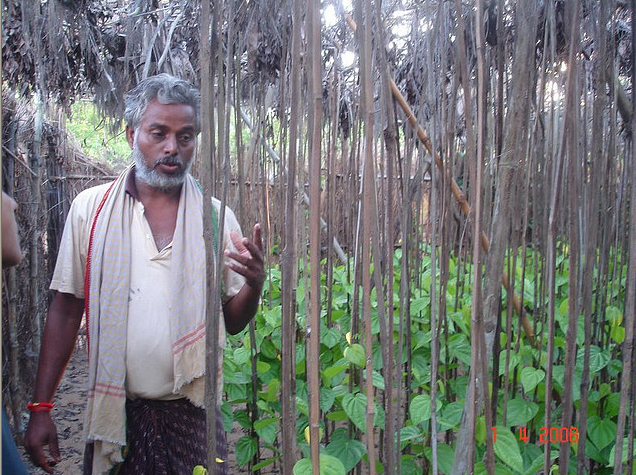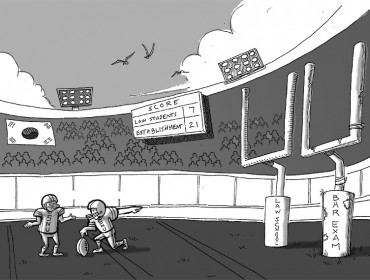By John Kay
I think everyone has heard the phrase, If a tree falls in the forest but no one sees, does it make a sound? The eastern Indian state of Orissa is not located in the media fashionable Middle East and North Africa (MENA); it has no strategic significance nor does it have any deposits of oil. But the issues of corruption, inequality, human rights, democracy and dignity that have brought people out on to the streets of Tunisia, Egypt, Yemen, Bahrain, Libya and Syria are the very same issues that have driven the inhabitants of Sundergarth, Keonjhar and Jagatsinghpur districts to oppose POSCO’s proposed captive port/plant and mine project continually over the last six years. The only difference being that India is supposed to be the world’s largest democracy, whereas the MENA are for the most part still ruled by monarchs or autocrats. The local fight against the amassed might and wealth of POSCO-India, the government of Orissa and the government of India, and their attempt to illeg ally push through this proposed port/plant and mine project is like the proverbial Zen tree in the forest.
ally push through this proposed port/plant and mine project is like the proverbial Zen tree in the forest.
It is my belief that a tree, whether or not anyone hears it, does make a considerable noise when it falls in the forest. Just because you haven’t heard of Orissa, Jagatsinghpur district, the Adivasis and their righteous opposition doesn’t mean that they don’t exist. If POSCO and the corrupt government of Orissa get their way, it is very probable that the Adivasis, their culture and way of life, not to mention the forest that they help sustain and that sustains them will be totally destroyed. This is one of the main reasons I’m bringing this injustice, this unfinished David and Goliath story, from unfashionable and underdeveloped Orissa in Eastern India to your attention.
In 2005, POSCO, through its subsidiary POSCO-India, signed a memorandum of understanding (MoU) with the Government of Orissa (GoO) in eastern India to build a 12 million tonnes per year steel plant with a captive port and iron ore mines, promising to invest a staggering $12 billion; making it potentially the largest infusion of Foreign Direct Investment (FDI) since the Indian economy liberalized in 1991.
POSCO itself was nurtured as a state-owned enterprise (SOE) by nationalized bank credit, public investment, and well-designed protectionist policies (all hallmarks of the South Korean model of state-led development) starting in 1968. It became a world-class steel producer in the late 1980s and remained so into the 1990s. Since 1997, there was a systematic privatization of POSCO (largely due to the economic crisis affecting all Asian “Tiger” economies) and increased foreign investment in POSCO. Only in 2000 when the South Korean state divested its shares from the company as part of its privatization policy, did POSCO become a private corporation. As Cambridge economist Ha-Joon Chang has convincingly shown in his book Bad Samaritans: The Myth of Free Trade and the Secret History of Capitalism, recently privatized enterprises such as POSCO “try to underplay, if not exactly hide, the fact that it became a world-class firm under state ownership”.![poscomap[1]](http://thethreewisemonkeys.com/wp-content/uploads/2011/05/poscomap1.jpg)
POSCO, working with a different state, also plans to build an 89 km water pipeline, a highway, a railway line and a township all in Orissa. The Government of Orissa have repeatedly claimed this project will “bring prosperity and well being to its people.” The iron ore mines in Keonjhar and Sundergarth districts will feed the steel mill proposed at Jagatsinghpur, which is home to approximately 4000 families; a total of 22,000 people. Jagatsinghpur also has the dubious honour of being chosen as the site for the captive port at the mouth of the Jatadhar river.
Most statistics and figures continually regurgitated by the organizations mentioned above are from a report produced by the National Council for Applied Economic Research (NCAER) in 2007: which was partially funded by POSCO itself raising serious doubts as to its objectivity and independence. The NCAER report makes two major claims both of which upon closer scrutiny, are blatantly inaccurate. The first claim is that the proposed POSCO project will over the next 30 years create 870,000 new jobs. Thereby virtually eliminating unemployment in the State of Orissa. The second claim is even more farfetched, if that is possible. It is that even though the proposed steel plant, port and mines project will be located in a SEZ (Special Economic Zone) ‘which is a specifically created duty free enclave, deemed to be foreign territory for the purposes of trade operations, and duties and tariffs’. The tax revenues accrued by the State of Orissa will be greater than if the entire project was in a Domestic Tariff Area (DTA). Now, maths is not my strong suit but even I can see that this is nonsense. Furthermore this highly dubious NCAER report with its fantastical approach to statistical research and basic maths is the only report both POSCO and the Government of Orissa have ever used to back up their claims about the benefits of the project.
But POSCO and the Government of Orissa have got the cart before the horse. Prior to talking about the supposed benefits of this proposed mega-project they should check the facts on the ground. The land; everything quite literally rests on the land. Out of the 4004 acres illegally allocated 3096 acres are designated as forest land and as such are subject to the Forest Rights Act (FRA) which does two things: it grants legal recognition to the rights of the traditional forest dwelling communities and quite clearly states that no forest land can be given to anyone until, 1) all the rights of the people in the area are recognized; and 2) their consent is given. The local people in Jagatsinghpur district through their local village councils (Gram Panchayats) have collectively refused to give their consent to the allocation of their land for the proposed plant/port project.

At the site allocated for the steel plant and port there is a thriving agricultural economy centred on but not limited to betel vine cultivation. Betel vine cultivation is possible on very small plots of land and provides a steady and reasonable income both to the owner-cultivators and to wage labourers. An estimated 22,000 people will be displaced and this profitable and functioning agricultural economy will be totally destroyed, if POSCO gets its way. Betel vine cultivation usually only takes place on very small plots of land because it is highly labour-intensive. The average size of vine plots range from 2 to 30 decimals (a decimal being a hundredth of an acre). Betel vine is grown using a shed made of bamboo and/or casurina trees with other forest produce used to create the cover to protect the vine from direct sunlight. Farmers buy bamboo but the sun-filtering cover is gathered from the forest. Within each shed rows of a kind of scaffolding about one foot from the next are set up. This scaffolding made of thinner bamboo or casurina reeds is about 7 feet high. On each scaffold one betel vine grows vertically. So one betel vine shed houses many rows of vines, though the exact number of vines depends on the size of the plot of land or of the shed. It takes three months for a vine to grow to its full size.
According to the Mining Zone People’s Solidarity Group report the current price (recorded July 12-19th, 2010) was Rs 0.60 (rupees) per leaf (1 Indian rupee = 0.02 U.S. dollars); the average price being Rs 0.57 per leaf. Family labour is usually the norm in betel vine cultivation; from constructing the shed and scaffolding, weeding, preparing soil (mixing mustard seeds and sand, once a month) to picking the leaves. However, hired workers are also employed throughout the year. Hired workers are paid between Rs 150/240 per day depending on the task plus two meals. Though betel vine is the main source of income, the majority of farmers also grow cashew nuts as a cash crop, and rice for household consumption. Fish caught in local rivers are also used to supplement family diet, except during monsoons. People also harvest a vast variety of fruits and vegetables from the forest, such as bitter gourd, drum stick, drum stick leaves, potato, desi potato (a local variant that is much bigger), squash, guava, mango and jack fruit. Studies have shown that such fruits and vegetables found in the forest are a very valuable nutritional addition to the diet of rural households.
The average income from betel vine cultivation for a farmer is Rs 40,000 per year per decimal (100 decimals = 1 acre) of land. Yet the compensation package on offer from POSCO in the steel plant area is only a measly one-time payment of Rs 13,000. Therefore the total loss experienced by a betel farmer over the 30 year time frame would be Rs 1,200,000. Which makes the POSCO compensation offer less than 1% of their potential earnings.

Along with betel vine farming there are three other main means of livelihood. daily wage labourers, who although they have access to some land identify themselves as landless because either the land they own is very small or they do not own pattas (or legal title) to the land they cultivate. Still these (predominantly) men, solely by working for slightly more prosperous neighbours can make between Rs 46,800 ($1,114) and Rs 74,880 ($1,782) a year. The latter figure which is actually higher than the GDP per capita average of $1,176. Others not involved in betel vine and other cash crop cultivation are involved in fish farming as their main livelihood. This minority has been able to invest in pisciculture, and fish farms according to the MZPSG report ‘extend across the entire project-affected area except the Nuagaon’. And finally the last group in the affected area is the fisher folk. Some 20,000 to 25,000 small scale fisher folk work on the Jatadhar River and the bay area adjoining it. This area would be obliterated by POSCO’s planned captive port. Significantly fisher folk tend to depend solely on fishing ‘and rarely enter any other labour market’. Although no research has been systematically done to ascertain income levels from fishing, it is self-evident that a significant number of people rely on both the Jatadhar River and the bay area for their sole livelihood. What would become of these 20,000 to 25,000 people and their families if POSCO’s captive port project was to be given the all clear and built at the mouth of the Jatadhar River? It is quite clear that POSCO hasn’t deemed this a question worthy of consideration as the fisher folk are totally absent from all compensation plans; sadly the same is true for the inhabitants of the districts where the proposed iron ore mines allocated to POSCO are located.
Two locations have been chosen for POSCO’s proposed project; Jagatsinghpur near the mouth of the Jatadhar river, for the steel mill and captive port; and Keonjhar and Sundergarth districts in the Khandadhar hills, where the iron ore mines will be. Although neither the Government of Orissa nor POSCO have ever specified the exact location of the mines, information gathered from two lawsuits filed against the allotment of mines to POSCO and from government notices reveal that 32 villages in Keonjhar district and 84 villages in Sundergarth district will be affected. Of the 32 villages inhabitants of 12 villages will be displaced; residents of a further 20 villages will lose their sources of livelihood and access to water. For Sundergarth district such detailed information was unavailable. But imagine if your livelihood suddenly became unavailable; your employer decides you’re surplus to requirements and immed iately gets on the phone to immigration. That in itself would be a massive blow and would greatly affect your life and those of your dependents. Then suppose your access to water was also cut. What more is there to lose? Maybe it’s possible to somehow live with a drastically reduced income or even next to no income at all. But who can live without water? Who should have to live without water, or clean water for that matter? So much for the glib and vacuous phrase ‘Golden Orissa, Golden Life’ that adorns several POSCO press releases.
iately gets on the phone to immigration. That in itself would be a massive blow and would greatly affect your life and those of your dependents. Then suppose your access to water was also cut. What more is there to lose? Maybe it’s possible to somehow live with a drastically reduced income or even next to no income at all. But who can live without water? Who should have to live without water, or clean water for that matter? So much for the glib and vacuous phrase ‘Golden Orissa, Golden Life’ that adorns several POSCO press releases.
Here’s another press release found on POSCO-India’s website entitled ‘POSCO-India in Socio-Economic Landscape of Orissa’; with such a catchy and grammatically correct title how could I resist. It mentions certain ‘project highlights’ including the Rehabilitation & Resettlement package; in which it is claimed that ‘only’ 4004 acres of land is required for the steel mill; that only 438 acres are private land, and that ONLY 47 families will be displaced by the proposed project. This willfully overlooks the 3096 acres that is prime forest land; which is protected by the Forest Rights Act. Overlooking this highly significant fact is almost criminal considering the vociferous local opposition to this project and the on-going repression of said opposition by the Government of Orissa and its security forces. By claiming that only 438 acres of private land are needed and that only 47 families will be displaced, conveniently airbrushes out of the equation some 4000 families and approximately 22,000 people. This is some sleight of hand—commendable if you are a world renowned illusionist but not if you’re a large conglomerate whose press releases claim a grand fraternity and benevolence toward the people of Orissa.
Further analysis of the POSCO press release titled ‘Golden Orissa, Golden Life’ is necessary, especially under the heading ‘Development of Infrastructure in the Project Area; steel industry will bring infrastructure of roads, railways, power plants and water facilities’. Mining and other industrial activities in other parts of Orissa have already led to a drastic reduction in the water table as well as the destruction of several waterfalls and streams. Waterfalls and the area around them are highly sought after ‘because mining companies consider the origins of natural or perennial streams as perfect for extracting good quality iron ore. In fact, a report by Duskar Barik, a local activist in the Keonjhar region, claims that ‘almost all the perennial streams in the mining area of Keonjhar district are dead’. According to Barik, eight perennial streams in the Gandhamardan Hill range (where POSCO’s iron ore mines are to be) have already been killed and this destruction has affected at least 9 villages; due to activities of the Orissa Mining Corporation and its sub-contractor. The people in the area mostly survive on subsistence agriculture and this is dependent on the streams and rivers for irrigation. It is not hard to see that further mining could lead to the complete drying up of the main bodies of water in the area.
In the original MoU that the Government of Orissa (GoO) signed with POSCO ‘not only are limits on POSCO’s use of water missing, the agreement allows POSCO to set up its own water supply system and draw as much water as it needs- in effect free water’. So in effect POSCO has been given an unlimited and free supply of water and as part of its pledge to bring development and progress—not unlike the British East India Company a few hundred years earlier—is generously going to provide some water facilities (what kind or how many is not specified) to the people of Orissa; the water that belongs to them in the first place. Another point is that the second crucial requirement of betel vine (Paan Kheti) cultivation is the local availability of sweet water to irrigate plots. In almost all small farms or plots of land that cultivate betel vine the water source is within 20 metres of the plot; and it was accessed through a simple insecure well. Even though the water source is close to the plots, the water is located on forest land, and the water table is very high; most wells are less than 20 or 30 feet deep. Miraculously the water available is sweet; I say miraculously because ‘we need to understand the complex ecological process that allows for the water table less than a kilometer or two from the coast line to have no trace of brackishness,’ according to Barik.

Finally on the issue of water, the amount of water promised to POSCO is the highest volume of water ever allocated to any project in Orissa. This allocation of water (which is a local natural resource) totally ignores popular opposition on the ground against further depletion of water from the Hirakud dam, which is primarily meant for irrigation. Opposition group Mahanadi Banchao Andolan also believe that further industrial use would lead to a water crisis downstream in several rural areas including Cuttack, Jajpur, Kendrapada and Jagatsinghpur districts; therefore it is demanding the state government revoke its approval of water to POSCO. Unfortunately this is just the tip of the iceberg as the Government of Orissa has signed MoUs with a further 86 companies, 46 of which have been given permission to draw water from the rivers. So the prospects are bleak, the water table is going to drop, rivers and streams are going dry up.
Another concern is that the bodies of water that are left are going to be heavily polluted by industrial waste; particularly from POSCO’s planned iron ore mines in the hill districts of Sundergarth and Keonjhar. Previous mining activity by the Orissa Mining Corporation led to a 4 metres decrease in the water table. In light of these well researched conditions, POSCO’s promise to build water facilities accessible to the people of Orissa smacks loudly of hypocrisy. How can POSCO, which must know the situation in the districts of Sundergarth and Keonjhar, for which it has such ambitious plans, offer back to the people of Orissa the very water it is in the process of stealing from them; Does POSCO expect gratitude from the people of Orissa under the guise of development and progress? For POSCO share holders certainly. But exactly who are these shareholders and do they have any concern with the issues that the people of Orissa are facing?
In part two I will cover my communications with the Asian Human Rights Commission, POSCO Pratirodha Sangram Samiti (the Anti-POSCO Mobilization Committee), the Korean Civil Society Alliance and the numerous further revelations regarding POSCO-India’s proposed project in Orissa.







